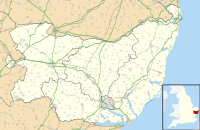Ipswich Castle facts for kids
Quick facts for kids Ipswich Castle |
|
|---|---|
| Ipswich, Suffolk, England | |
| Coordinates | 52°03′30″N 1°09′24″E / 52.0584°N 1.1566°E |
| Site information | |
| Condition | Destroyed |
Ipswich Castle was a medieval castle. It was located in the town of Ipswich, Suffolk, England. Today, nothing remains of this old castle.
The Castle's Story
Building the Castle
Ipswich Castle was built after the Normans took over England in 1066. The exact spot where it stood is a bit of a mystery. Some historians think it was where the Ipswich arboretum is now. Others believe it was on a small hill near St Stephen's church.
Powerful Families and Conflicts
By the 1100s, a very powerful family called the Bigods controlled much of Suffolk. They held the important title of the Earl of Norfolk. This family owned several large castles, including Framlingham, Bungay, Walton, and Thetford.
However, there were often disagreements between the Bigod family and the King. Hugh Bigod was one of the noblemen who disagreed with King Stephen. This happened during a time of civil war in England called the Anarchy. Hugh Bigod controlled Ipswich Castle during this period. In 1153, King Stephen marched into Hugh's lands and took control of Ipswich town and its castle.
The Castle's End
Later, Henry II became King. He wanted to make sure the royal family had strong control over the area. At this time, Hugh Bigod had regained control of Ipswich Castle. In 1157, King Henry II took away the main Bigod castles from Hugh.
Despite this, Hugh Bigod continued to cause trouble. In 1173, he joined a rebellion against King Henry II led by the King's own sons. This attempt to overthrow King Henry II failed. As punishment for the Bigods' rebellion, King Henry II ordered Ipswich Castle to be destroyed in 1176.
The castle was never rebuilt after that. Today, there are no parts of Ipswich Castle left to see.


